Comparison sneak "Two Balls" from the 60s and 2016. From the sole to the laces
Hey. This is the blog of the Two Balls team . Since 2016, we produce legendary sneakers of the 60s. Our goal was not just a replica for the sake of design, but a completely authentic product made according to the Soviet GOST standards, shoes and with the ideology of affordable, but high-quality footwear.
Today we offer you to compare the model of “balls” from the 60s with their reincarnation from 2016. Such comparisons have already been made, but it is important for us to keep checking with the original all the time to maintain quality. We also hope that it will be interesting to learn about the vicissitudes of the restoration of Soviet brands first hand. Enjoy reading!
And we begin with a brief historical excursion for the younger generation.

In 1957, the Sixth World Festival of Youth and Students was held in Moscow, where the Soviet public, accustomed to Czechs in the gym and shoes on the street, saw for the first time gym shoes for foreign students. After a while, GOST 9155-88 "Rubber footwear and rubber-textile footwear" appeared in the Union, and Chinese and North Korean sneakers came into the country.
Less than a decade later, the USSR began manufacturing its shoes in China, and in 1965 the first Two Shoes sneakers saw the light. Until the 80s, “sneakers” - as the writer Eduard Limonov called them - were the most desirable shoes and made their way from gyms and stadiums to the underground, becoming the symbol of an informal get-together. The availability of the “balls” made them a cultural asset, and if you now look at photos of those years, you can easily find Egor Letov, Gagarin, Electronics, basketball player Sergei Belov, Tsoi, and even the wolf from “Well, wait a minute!” In the Two Balls sneakers.
Let's start the comparison
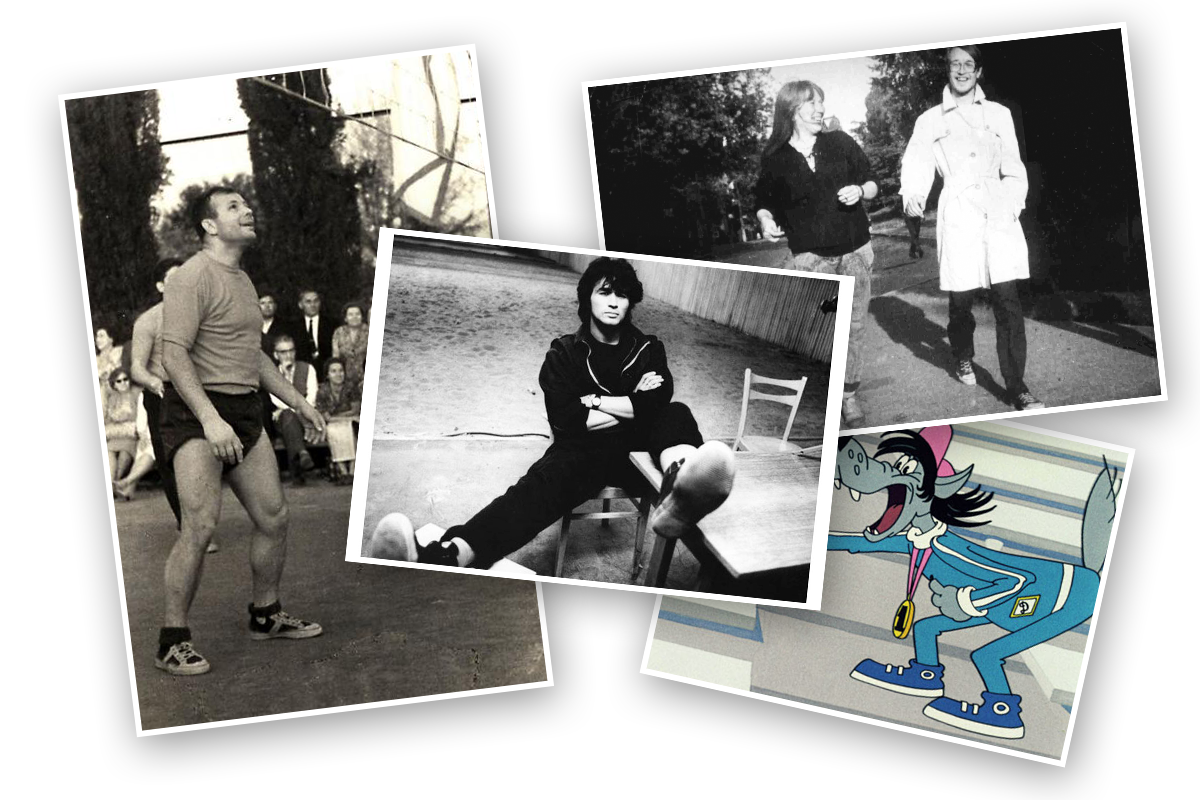
The buyer gets sneakers here in this box. A laconic, clean design with no frills, thick cardboard is quite suitable for transportation and winter storage, and if you want to present a gift, you can even not pack it in a wrapper. More from the box and is not required.
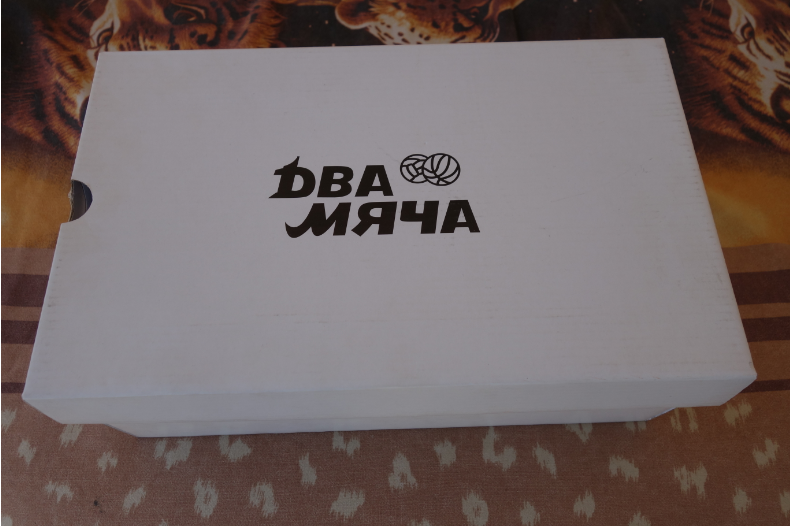
Inside - wrapped in craft paper "balls", with embedded paper filler to keep the shape.
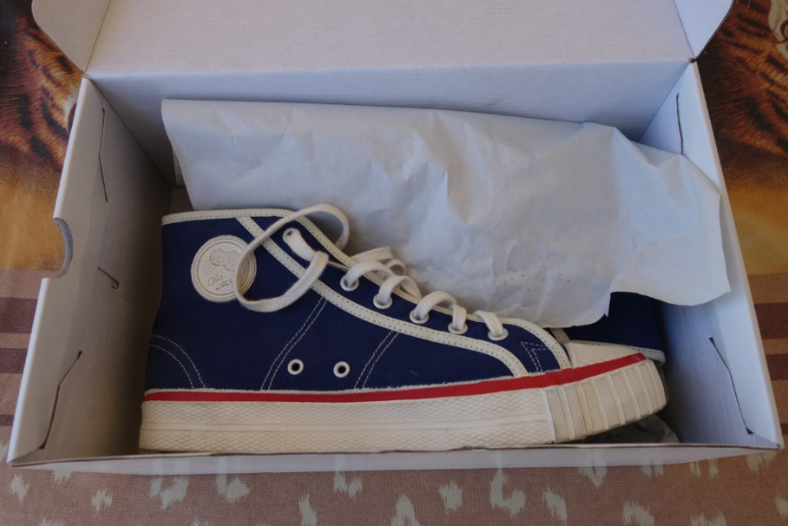
We get, and first thing we check the size. "43, made in China" - reads the table on the tongue. In old shoes of the 69th year, information about the size is duplicated on the tongue and the ankle zone.
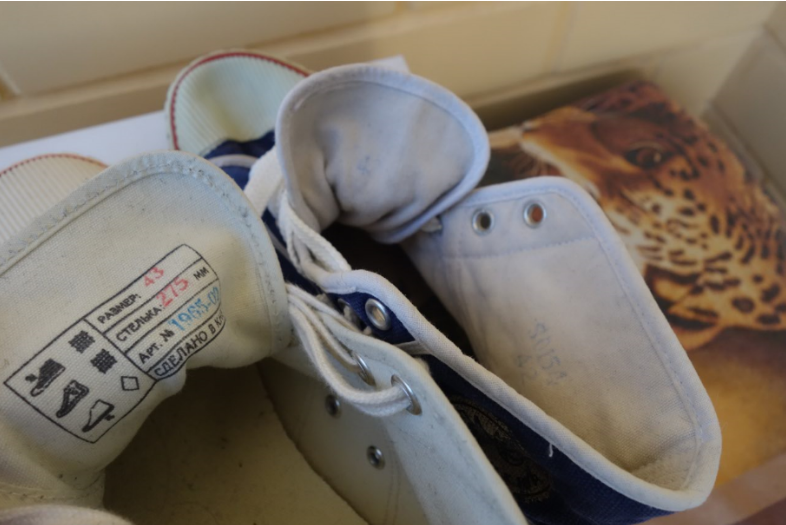
In the new sneakers, the same block is used, which was restored by the old “balls” bought on Avito. The only difference is that we have added completeness, since the average Russian leg is somewhat wider than the European.
We look deeper and see the “Two Balls” logo on the insoles. The font is the same, but the quality of printing on new sneakers is much better. All logos on sneakers are put by hand, as before.

We take out the insole and meet the same logo and another insole. Yes, there are two insoles, and one of them is orthopedic. It is needed to support the legs and correct biomechanics when walking on a flat sole.
But in the old “balls” the insole was not there, because often after purchase it was simply thrown out and changed to a wool sock, or it was worn like this - with one insole. This is due to foam rubber - a heavy and tough material that was used at the time.
In the new sneakers, a triple layer of depreciation is used: the sole, the insole, the insole with the arch support. Foam rubber has been replaced by EVA (ethylene vinyl acetate) orthopedic material used in running shoes. The material is lightweight, elastic and durable, and the factory where we order the insole collaborates with Nike and New Balance.
In the USSR, sneakers until the very end were considered sports shoes. "Balls" were a frequent guest on basketball courts and soccer fields. Over the ocean, the situation was similar (remember the legendary Onitsuka Tiger), but with the arrival of sneakers, overseas sneakers turned into a purely fashionable footwear. Image image, but even a walk on the "bare" rubber often turns into torture.
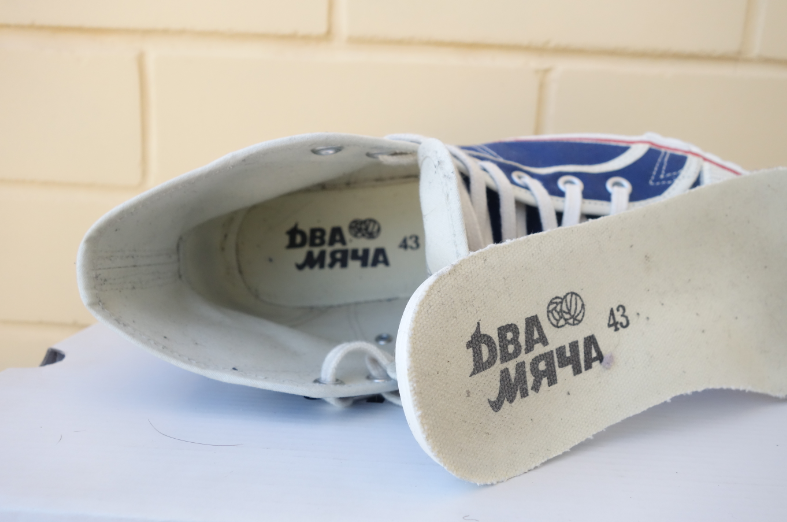
The "veterans" even glide along the floor at home, and the material of the sole is too soft - each stone will be felt when walking. It also quickly licks and leaves green stripes on the surface.
We cast a new sole from better and more dense rubber DM-0.3. For the tread pattern, a plaster cast was taken from another, older, “ball” model, from which a 3 D scan and a mold were made.
To get the right sole, the creator of the new “Two Balls” Yevgeny Raikov had to move to China for two years, learn Chinese and personally control production.
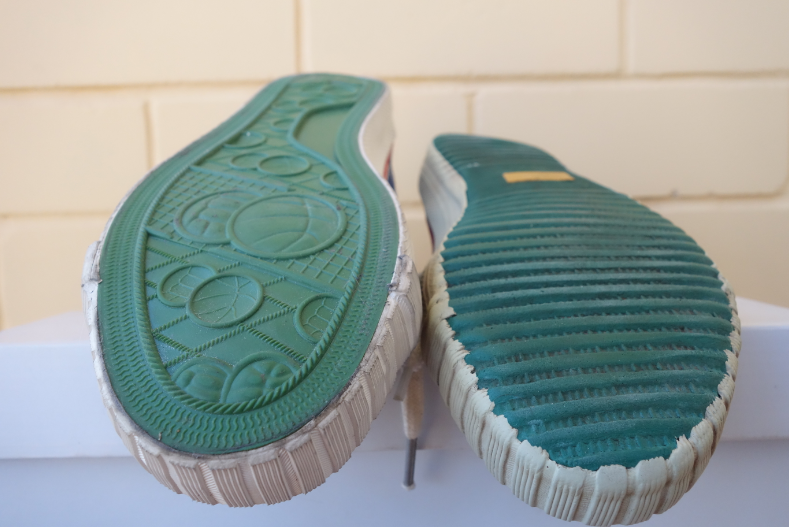
We smoothly go to the top, but first we will understand how the sole is attached to this top.
By production of "balls", as well as 54 years ago, the method of boiler vulcanization is used.
After assembling all the rubber elements, the sole and the upper part, stretched on the block, are combined. All this construction is sent to a vulcanization boiler, where, at a temperature of 200 ° C, rubber and fabric are glued together by adhesion - adhesion of surfaces of dissimilar materials. After removing the shoe from the boiler, the sole and top joint is manually coated with liquid rubber for even greater reliability and to prevent kinks.
The result is a monolithic construction without a drop of glue.
In our time, this method is very rare. Most popular sneakers are made by planting the top and sole on glue - this has a good effect on the speed and price of production, but negatively on reliability, convenience and durability.
Soviet sneakers greeted us with sincere “Two Balls. Made in K.N.R. "on the logo. New modest - got off with only the name.
And old sneakers have a different white tape and there is no ventilation on the inside of the foot. The models are slightly different (the new model is called 1965 for the years of development, and the old one is the 1969 model year), so the design is slightly different.
From the outside, everything is the same, only new sneakers have another brand logo on the sole.

All exterior elements, whether it be beyki, logos, painting or points - are made by hand, as before. To complete readiness sneakers pass through 40 pairs of hands! Therefore, small errors may occur from instance to instance: a line offset of half a millimeter or a slightly unevenly sewn logo. With manual assembly without it anywhere. However, this does not affect the reliability, but it gives each pair of “balls” its own individuality.
Both models boast a tight 16-oz 100% cotton. 16 ounces! - Classic cotton kimonos for professional sports performances are made from cotton of such density. The material is damn durable, as evidenced by the safety of 40-year-old sneakers. In the Union there was no concept of "planned obsolescence", so that shoes were made for centuries. In modern sneakers from other manufacturers, the maximum that can be expected is 8-12-oz cotton, and, if lucky, without the addition of synthetics.

Cotton is not only the top, but also the laces. They have authentic weaving, color to match the basic material of the shoe, and, unlike synthetic ones, they stretch their legs much better and are not untied by themselves. Laces are crowned with metal tips with the Two Ball logo.

The cringles in the new sneakers are made of higher quality aluminum, and the design of the rings is seamless. In the old “balls” the seam is clearly visible. Affected technical progress.
But no matter how much progress there is, it does not reduce the stages and difficulties in creating a shoe. So, only for the production of laces, tips and grommets requires 5 factories. Tips and grommets are made in different provinces, after which they are taken to one factory for joint galvanization so that their color is the same. Then the tips go to another factory to apply the logo, and finish their way at another factory, where they are connected with laces.
In general, it turned out "Vintage without fanaticism." All the best, including the authentic design and technology of those years, was abandoned, but the materials were selected modern. The new “Two Balls” have excellent road performance, do not spoil the legs, and are distinguished by some kind of abrasive wear resistance for our times.
And they have a modern price. At that time, “Two Balls” were the most expensive in the open spaces of the Union, and cost 4 rubles. From November 22 to November 25, “Two Balls” sneakers can be bought with a 50% discount, for just 1,900 rubles on our original manufacturer’s website .
Today we offer you to compare the model of “balls” from the 60s with their reincarnation from 2016. Such comparisons have already been made, but it is important for us to keep checking with the original all the time to maintain quality. We also hope that it will be interesting to learn about the vicissitudes of the restoration of Soviet brands first hand. Enjoy reading!
And we begin with a brief historical excursion for the younger generation.

How it all began
In 1957, the Sixth World Festival of Youth and Students was held in Moscow, where the Soviet public, accustomed to Czechs in the gym and shoes on the street, saw for the first time gym shoes for foreign students. After a while, GOST 9155-88 "Rubber footwear and rubber-textile footwear" appeared in the Union, and Chinese and North Korean sneakers came into the country.
Less than a decade later, the USSR began manufacturing its shoes in China, and in 1965 the first Two Shoes sneakers saw the light. Until the 80s, “sneakers” - as the writer Eduard Limonov called them - were the most desirable shoes and made their way from gyms and stadiums to the underground, becoming the symbol of an informal get-together. The availability of the “balls” made them a cultural asset, and if you now look at photos of those years, you can easily find Egor Letov, Gagarin, Electronics, basketball player Sergei Belov, Tsoi, and even the wolf from “Well, wait a minute!” In the Two Balls sneakers.
Let's start the comparison

Packaging
The buyer gets sneakers here in this box. A laconic, clean design with no frills, thick cardboard is quite suitable for transportation and winter storage, and if you want to present a gift, you can even not pack it in a wrapper. More from the box and is not required.

Inside - wrapped in craft paper "balls", with embedded paper filler to keep the shape.

What's inside
We get, and first thing we check the size. "43, made in China" - reads the table on the tongue. In old shoes of the 69th year, information about the size is duplicated on the tongue and the ankle zone.

In the new sneakers, the same block is used, which was restored by the old “balls” bought on Avito. The only difference is that we have added completeness, since the average Russian leg is somewhat wider than the European.
We look deeper and see the “Two Balls” logo on the insoles. The font is the same, but the quality of printing on new sneakers is much better. All logos on sneakers are put by hand, as before.

We take out the insole and meet the same logo and another insole. Yes, there are two insoles, and one of them is orthopedic. It is needed to support the legs and correct biomechanics when walking on a flat sole.
But in the old “balls” the insole was not there, because often after purchase it was simply thrown out and changed to a wool sock, or it was worn like this - with one insole. This is due to foam rubber - a heavy and tough material that was used at the time.
In the new sneakers, a triple layer of depreciation is used: the sole, the insole, the insole with the arch support. Foam rubber has been replaced by EVA (ethylene vinyl acetate) orthopedic material used in running shoes. The material is lightweight, elastic and durable, and the factory where we order the insole collaborates with Nike and New Balance.
In the USSR, sneakers until the very end were considered sports shoes. "Balls" were a frequent guest on basketball courts and soccer fields. Over the ocean, the situation was similar (remember the legendary Onitsuka Tiger), but with the arrival of sneakers, overseas sneakers turned into a purely fashionable footwear. Image image, but even a walk on the "bare" rubber often turns into torture.

Sole
The "veterans" even glide along the floor at home, and the material of the sole is too soft - each stone will be felt when walking. It also quickly licks and leaves green stripes on the surface.
We cast a new sole from better and more dense rubber DM-0.3. For the tread pattern, a plaster cast was taken from another, older, “ball” model, from which a 3 D scan and a mold were made.
To get the right sole, the creator of the new “Two Balls” Yevgeny Raikov had to move to China for two years, learn Chinese and personally control production.

We smoothly go to the top, but first we will understand how the sole is attached to this top.
By production of "balls", as well as 54 years ago, the method of boiler vulcanization is used.
After assembling all the rubber elements, the sole and the upper part, stretched on the block, are combined. All this construction is sent to a vulcanization boiler, where, at a temperature of 200 ° C, rubber and fabric are glued together by adhesion - adhesion of surfaces of dissimilar materials. After removing the shoe from the boiler, the sole and top joint is manually coated with liquid rubber for even greater reliability and to prevent kinks.
The result is a monolithic construction without a drop of glue.
In our time, this method is very rare. Most popular sneakers are made by planting the top and sole on glue - this has a good effect on the speed and price of production, but negatively on reliability, convenience and durability.
Top part
Soviet sneakers greeted us with sincere “Two Balls. Made in K.N.R. "on the logo. New modest - got off with only the name.
And old sneakers have a different white tape and there is no ventilation on the inside of the foot. The models are slightly different (the new model is called 1965 for the years of development, and the old one is the 1969 model year), so the design is slightly different.
From the outside, everything is the same, only new sneakers have another brand logo on the sole.

All exterior elements, whether it be beyki, logos, painting or points - are made by hand, as before. To complete readiness sneakers pass through 40 pairs of hands! Therefore, small errors may occur from instance to instance: a line offset of half a millimeter or a slightly unevenly sewn logo. With manual assembly without it anywhere. However, this does not affect the reliability, but it gives each pair of “balls” its own individuality.
Both models boast a tight 16-oz 100% cotton. 16 ounces! - Classic cotton kimonos for professional sports performances are made from cotton of such density. The material is damn durable, as evidenced by the safety of 40-year-old sneakers. In the Union there was no concept of "planned obsolescence", so that shoes were made for centuries. In modern sneakers from other manufacturers, the maximum that can be expected is 8-12-oz cotton, and, if lucky, without the addition of synthetics.

Cotton is not only the top, but also the laces. They have authentic weaving, color to match the basic material of the shoe, and, unlike synthetic ones, they stretch their legs much better and are not untied by themselves. Laces are crowned with metal tips with the Two Ball logo.

The cringles in the new sneakers are made of higher quality aluminum, and the design of the rings is seamless. In the old “balls” the seam is clearly visible. Affected technical progress.
But no matter how much progress there is, it does not reduce the stages and difficulties in creating a shoe. So, only for the production of laces, tips and grommets requires 5 factories. Tips and grommets are made in different provinces, after which they are taken to one factory for joint galvanization so that their color is the same. Then the tips go to another factory to apply the logo, and finish their way at another factory, where they are connected with laces.
findings
In general, it turned out "Vintage without fanaticism." All the best, including the authentic design and technology of those years, was abandoned, but the materials were selected modern. The new “Two Balls” have excellent road performance, do not spoil the legs, and are distinguished by some kind of abrasive wear resistance for our times.
And they have a modern price. At that time, “Two Balls” were the most expensive in the open spaces of the Union, and cost 4 rubles. From November 22 to November 25, “Two Balls” sneakers can be bought with a 50% discount, for just 1,900 rubles on our original manufacturer’s website .
